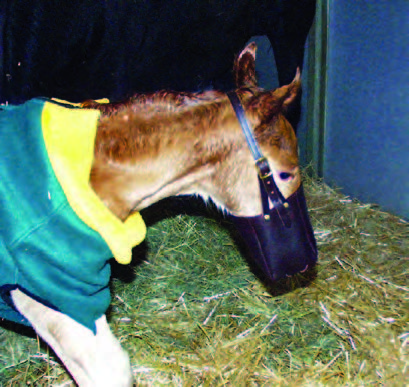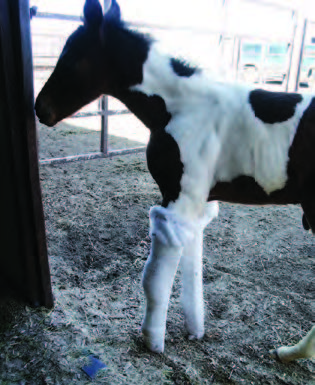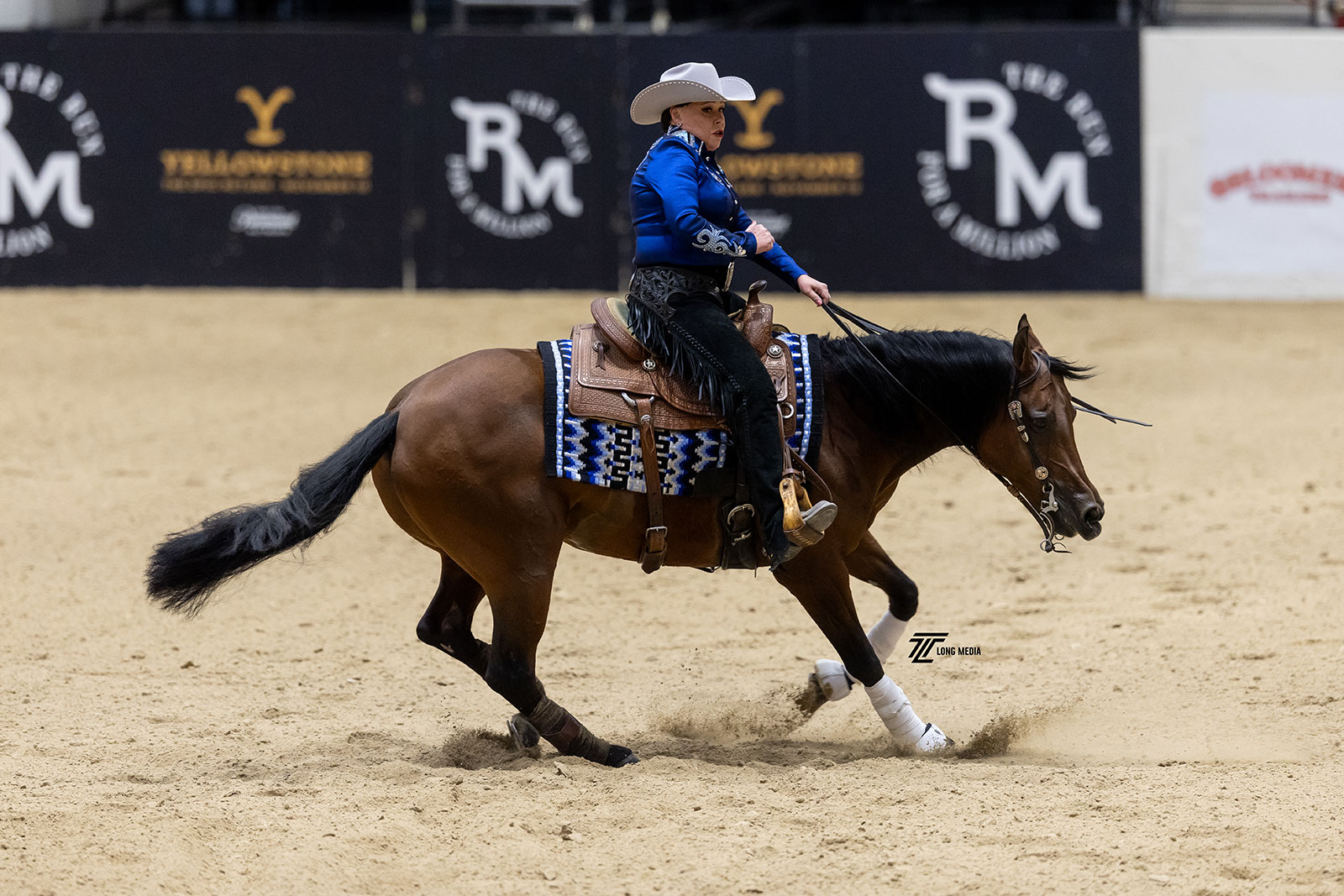By Cindy Reich
This column appeared in the June 2013 issue of Arabian Horse World.
Foaling season is still going strong – at least out here in the West. Although show and race breeders want early foals, most breeders are content to have them born when the weather and the grass are most advantageous for outdoor foaling. With June one of the most fertile months for mares to be bred, there is a second bubble of foals coming right now.
In the last few weeks there have been a number of cases that caused me to write down a few notes on some common problems that can occur throughout the season. Many have been explored in depth in previous columns, so this will be somewhat of an overview.
Neonatal Isoerythrolysis
Right now we have a mare in the foaling stall that is considered a candidate for having a neonatal isoerythrolysis (NI) foal. This condition results when a mare’s immune system has built up antibodies to the foal’s blood type. There are several ways this can occur. It can happen when a foal inherits a blood type from the stallion that is foreign to the mare (there are seven different blood groups in horses). Mares that have had multiple foals might have had some leakage from the placenta that allowed some blood from the foal to enter the mare’s circulatory system and sensitive against the foal. Mares that received blood products early in life may have a sensitized immune system as well.
What happens in an NI foal is that the antibodies the mare has formed against the foal’s blood type concentrate in her colostrum. The function of colostrum is to convey antibodies to the foal to protect it from disease until it develops its own immune system at 5 or 6 months of age. However, not all antibodies are helpful, and in the case of NI foals, the antibodies will seek out and destroy the foal’s red blood cells. Affected foals will become weak and jaundiced (displaying yellow mucous membranes and yellow eye sclera) at around 12-24 hours of age and can die. It is much easier to prevent this condition from happening in the suspected NI foal than to try to treat and save it if it is affected. Since the mare’s colostrum is only produced for approximately 24 hours, the fix is fairly easy. The foal should be muzzled immediately after birth. It should be fed on a bottle for at least 36 hours and the mare’s colostrum should be stripped and discarded. Obviously an alternate source of colostrum needs to be found for the foal because it can utilize the colostrum for the first 24 hours of life. Access to a colostrum bank is ideal, but if no alternate colostrum can be obtained, the foal will have to have plasma administered instead.

A foal with neonatal isoerythrolysis wearing muzzle to prevent nursing.

Foal with contracted tendons.

Foal fitted with splints to correct tendons that are too loose.
From a management perspective, it is a good idea to bottle-feed the foal with the foal positioned next to the mare’s flank and the bottle held near the udder. If you take the foal to a different part of the stall to bottle-feed it, it may not make the association between nursing and the mare’s udder. We usually let the foal nurse from the mare from 48 hours on. Once a mare has had an NI foal, she should be tested a few weeks before foaling for future foals, because her immune system has been sensitized. A blood sample from the mare can be sent to a specialty lab, but testing can only be done within a few weeks of foaling. An ounce of prevention, however, can save the life of a foal.
Tendon problems
Every year there are some foals that either have contracted tendons (too tight) or tendons lax (too loose). There was one of each in the last few weeks. The first foal had quite severe contracted tendons. A foal may be born with contracted tendons (it is a congenital condition) or it may develop contracted tendons weeks or months after birth. Although the cause is not completely understood, it is thought that contracted tendons at birth may result from how the foal was carried in the uterus. They could also occur from poor nutrition, or if the mare has produced foals before with the same problem, may have a genetic basis. It is important to work closely with your veterinarian because early treatment usually results in a better outcome. Mild cases may require nothing more than controlled exercise and time; the most severe could require surgery. However, contracted tendons should always be examined by a veterinarian.
Often, oxytetracycline is used for cases of congenital contracted tendons. The drug’s mechanism isn’t completely understood, but it may inhibit the strengthening of the tendon fibers and allow the tendons to relax and elongate as they bear the weight of the foal. Generally, for this treatment to work, it must be done in the first few days of the foal’s life. Again, consult with your veterinarian, as oxytetracycline can affect the kidneys adversely and must be used carefully. Furthermore, it doesn’t always work — especially if it is given too many days out from birth. These foals also normally need some anti-inflammatory and pain medication to lessen the pain associated with the stretching of the tendons. In the case I observed, the foal had not been treated because the owners hoped the foal’s legs would improve over time. They had bandaged the fetlock joint to give it some protection, but over time, the foal had worn pressure sores on the fronts of the fetlocks from the severe contracture. The sores had become infected, and the foal was ultimately euthanized. Would early intervention have helped? Very possibly, but then again, it was a very severe case, and the end result might have been the same.
Another foal arrived with the opposite problem. The tendons were too loose and the foal was walking on its fetlocks. Such foals usually need some sort of support in the form of splints. Nowadays there are lots of lightweight materials for splinting foal’s legs and they are combined with bandages so that the entire leg is never encased in a rigid structure. Not only will a rigid structure increase the potential of sores, it will also inhibit muscle use, which is necessary to strengthen the leg so that the problem can be resolved.
When I was about 10 years old, we had a foal that was born six weeks premature. When he tried to stand, his front legs bowed out, because they were not strong enough to support him. In those days, the only treatment was casting the legs. Initially we had to get him to his feet and lay him down, as he couldn’t do it on his own with the casts. Foals grow very quickly and although the casts were changed fairly frequently, it wasn’t frequent enough to prevent cast sores. If the sores had become severe enough, the foal might have had to be put down. Our foal was quite resilient and did survive, but he recovered because of his innate will and intensive management.
Usually after time in splints as the foal matures, the tendons strengthen. The foal with the lax tendons currently in the barn is on stall confi nement with bandages and splints. The prognosis is quite good with continued intensive management.
Milking problems in mares
Another foal was born recently to a dam who had rejected her foal the year before. She had been a maiden mare at the time, and most cases of foal rejection happen with maiden mares. The owner was alert and carefully monitoring the mare. After foaling, the mare accepted the foal, but had hardly any milk. The biggest cause of mares having very little milk at foaling is due to fescue toxicity; however, this mare had not been on fescue. The options available included supplementing the foal with a milk replacer, placing the foal on a nurse mare, or giving the mare a drug that could stimulate more milk production.
The owner decided to first try the treatment protocol before moving to more drastic measures. She also wanted the mare to have a positive experience of raising a foal if possible. However, if the mare did not produce more milk, it could actually set up a perfect storm for foal rejection all over again. A hungry foal working very hard to nurse can cause a lot of pain to the mare. As the foal becomes more aggressive in its attempts to nurse, the more painful the udder becomes and the more likely the mare is to keep the foal away from her. The veterinarian was consulted and the mare was treated with a drug called Domperidone, which works by blocking the hormone dopamine, an inhibitor of prolactin production. Prolactin is important in regulating milk letdown, and when the dopamine block is removed, the mare should begin to produce milk. In fact, it has been used to “create” nurse mares from mares who have not foaled at all, but who will produce milk when treated with Domperidone.
In this case the mare did increase her milk production. Not on a large scale, but enough so that the foal was able to get enough to thrive and also enough to prevent abusing the mare’s udder. The mare was able to raise a foal in a positive situation and it was all good. However, given this mare’s history, it is very likely that she could repeat her poor milk production next year if she is pregnant. Therefore, by working with the veterinarian, the owner can arrange to treat the mare prior to foaling with Domperidone and increase the chances that she will have plenty of milk for next year’s foal.
Problems with semen shipments
This seems to be an ongoing problem no matter what the time of year, but for some reason, I’ve heard more horror stories so far this year than in years past. Now, honestly, we have been shipping semen in horses since the early 1980s. It should not be that difficult, but for some reason, mistakes continue to be made on both sides of the shipping container. Responsible breeding farms should always include information with the shipped semen that includes:
• Stallion the semen was collected from and the date.
• Total concentration of ejaculate.
• Motility of ejaculate.
• Concentration of dose shipped (how many million/ml — the industry standard is 500 million/ml progressively motile spermatozoa for a breeding dose).
• Motility of extended breeding dose shipped.
• Extender used for shipment and rate of dilution.
It never ceases to amaze me that owners are continuing to receive semen shipment containers with either no information or very little. The mare owner is entitled to this information and it is essential to determine whether the quality of the semen shipped is suffi cient to reasonably expect a pregnancy. Always check a small aliquot (sample) of the semen before inseminating. If the motility is represented as 70 percent, for example, and you check it and find out it is actually 30 percent, it is going to have an effect on your results. Failure to quality check the product can result in an open mare, and the stallion owner will always blame the mare, just as the mare owner always blames the stallion. The real blame lies directly with the mare owner’s breeding personnel if the semen is not checked. What do you do if the sample is not as represented? The first step should always be to communicate with the farm that shipped the semen. Ideally, they would have placed a small, extended sample in a cooler to be checked the following day if there are problems. If their results still differ from the sample shipped, it might take some detective work to figure out why. Perhaps the semen had been mishandled during shipping or upon evaluation at the farm. Document everything and communicate, communicate, communicate. Too much information is rarely if ever a problem. Too little information is generally always a problem.
June is the month of the longest day, the weather is gentle but on the way to hot. This is one of the busiest months of foaling and breeding for the “natural” season. Enjoy this month of spring-into-summer before the really hot weather starts.






